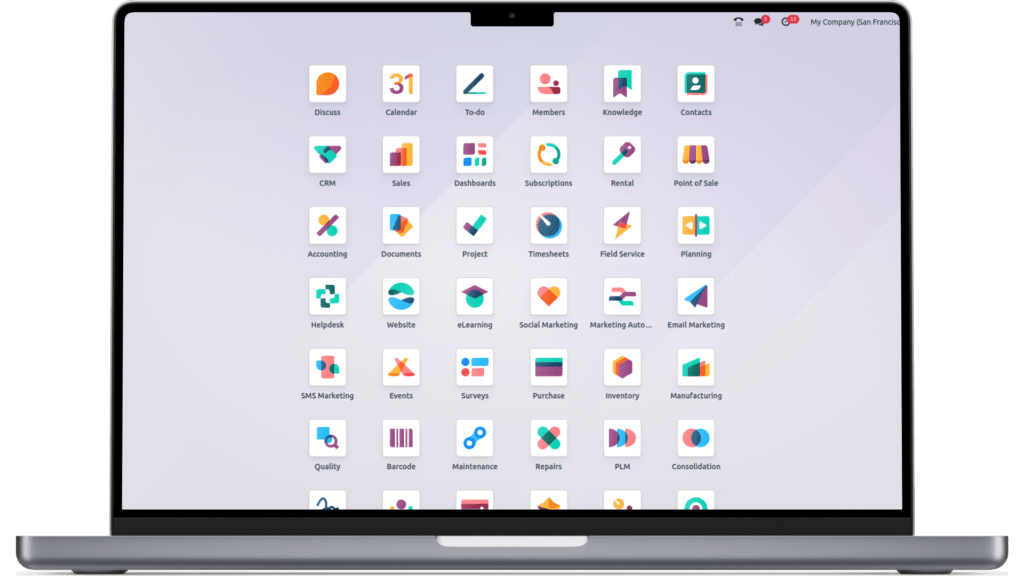
Implement ERP: A Guide to Success
Enterprise Resource Planning (ERP) systems are powerful tools that can revolutionize your business. However, to implement ERP software is a complex undertaking process. A successful ERP implementation can streamline operations, improve efficiency, and boost your bottom line. However, a poorly executed implementation can lead to cost overruns, delays, and frustration.
What Makes ERP So Powerful?
- Streamlined Operations: ERP eliminates data silos and manual processes, creating efficient workflows across departments like finance, sales, inventory, and human resources.
- Improved Efficiency: Automation and real-time data access reduce manual effort, allowing your team to focus on more strategic tasks.
- Boosted Profits: By optimizing operations, reducing errors, and improving decision-making, ERP can significantly impact your bottom line.
- Enhanced Collaboration: ERP systems provide a single source of truth for all business data, fostering better communication and collaboration across teams.
- Data-Driven Insights: Real-time data and analytics empower you to make informed decisions based on accurate information.
But Beware of the Pitfalls…
While the potential benefits are immense, ERP implementation is not a walk in the park. It’s a complex undertaking that requires careful planning, significant investment, and ongoing commitment. A poorly executed implementation can lead to:
- Cost Overruns: Unforeseen challenges, inadequate planning, and scope creep can inflate the project budget.
- Project Delays: Without proper project management and resource allocation, implementation can drag on, disrupting your business.
- Frustration and Resistance: Poor communication, inadequate training, and lack of user support can lead to frustration and resistance among employees.
- System Failure: In the worst-case scenario, a failed implementation can leave you with a system that doesn’t meet your needs and a significant financial loss.
Navigating the ERP Journey:
This guide serves as your roadmap, providing a step-by-step approach to successfully navigate the complexities of ERP implementation. By following these guidelines, you can mitigate risks, maximize your return on investment, and unlock the full potential of ERP to transform your business.

1. Define Clear Objectives and Scope
Before embarking on your ERP implementation journey, it’s essential to establish a clear understanding of what you hope to achieve. This involves defining specific, measurable, achievable, relevant, and time-bound (SMART) goals.
- Identify Pain Points: Begin by pinpointing the specific challenges your organization faces that an ERP system can address. Are you struggling with inefficient manual processes, data silos across departments, or a lack of real-time visibility into your operations?
- Envision the Future: Paint a picture of how your business will operate after a successful ERP implementation. Do you envision streamlined workflows, improved collaboration between departments, or enhanced decision-making based on accurate data?
- Scope it Out: Determine the boundaries of your ERP project. Which departments will be involved? What specific processes will be impacted? A well-defined scope helps prevent scope creep and keeps the project focused.
By investing time in this initial phase of defining objectives and scope, you lay a solid foundation for a successful ERP implementation that delivers tangible results and aligns with your overall business strategy. This clarity will guide your software selection, resource allocation, and change management efforts throughout the project.
2. Secure Executive Buy-in and Assemble a Dedicated Team
Implementing a new ERP system isn’t just an IT project; it’s a company-wide initiative that requires strong leadership and a collaborative team effort. To succeed, you need everyone pulling in the same direction.
Why You Need Leadership Support:
- Resources: ERP projects require investment in software, hardware, and people. Leaders need to understand the value proposition and commit the necessary resources.
- Decision-making: Tough choices will need to be made throughout the process. Having leadership buy-in ensures decisions are made swiftly and effectively.
- Motivation: Change can be challenging. Leaders need to champion the ERP project, communicate its benefits, and motivate employees to embrace the new system.
Building Your ERP Dream Team:
Don’t just leave it to the IT department! A successful ERP implementation requires a diverse team with representation from all key areas of the business. This includes:
- End-users: Those who will be using the system daily can provide valuable insights into their needs and workflows.
- Department heads: They understand the specific requirements and challenges within their areas.
- IT specialists: They provide technical expertise and ensure smooth integration with existing systems.
- Project manager: A dedicated project manager keeps the project on track, manages timelines, and coordinates communication.
This cross-functional team will be responsible for planning the implementation, executing the project, and providing ongoing support to users after the system goes live.
In short: Strong leadership support and a dedicated, diverse team are essential ingredients for a successful ERP implementation.
3. Hire a firm to implement ERP
Implementing a new ERP (Enterprise Resource Planning) system can be a daunting task for any business. From selecting the right software to managing data migration and training employees, the process is complex and requires specialized expertise. That’s where hiring an experienced ERP implementation firm can make all the difference. These firms bring a wealth of knowledge and best practices to the table, ensuring a smoother, more efficient, and ultimately more successful implementation. They can guide you through every step of the process, from initial assessment and planning to go-live support and beyond, minimizing disruptions to your business and maximizing your return on investment.
By partnering with an ERP implementation firm, you gain access to a dedicated team of professionals who understand the intricacies of ERP systems and implementation challenges. They can help you navigate complex technical issues, manage change effectively, and ensure your new system aligns with your specific business needs and goals. Ultimately, hiring an ERP implementation firm can save you time, money, and resources, allowing you to focus on what you do best – running your business.
4. Choose the Right ERP System
The ERP market is bustling with options, each catering to different needs and business sizes. Here are some of the leading ERP software solutions available:
Tier 1 (Enterprise-grade, Most Expensive):
- SAP S/4HANA: A comprehensive suite covering all core business functions, known for its robust functionality but can be complex and expensive.
- Oracle NetSuite: Cloud-based ERP with strong financials, excellent for multi-national companies and complex organizations.
- Microsoft Dynamics 365: Highly adaptable and integrates well with other Microsoft products, offering various applications for different needs.
- Infor: Industry-specific cloud suites catering to manufacturing, distribution, healthcare, and more.
Tier 2 (Mid-market focus, Expensive):
- Sage Intacct: Strong accounting focus, excellent for financial management and reporting.
- Acumatica: Cloud ERP known for its user-friendly interface and flexibility, popular with growing businesses.
- Epicor: Offers both cloud and on-premise solutions with industry-specific functionality for manufacturing, distribution, and retail.
Tier 3 (Niche-solutions, Affordable):
- Odoo: Open-source ERP with a modular design, highly customizable but requires technical expertise.
- Zoho: Offers a suite of business applications including CRM and ERP, affordable and user-friendly.
- ERPNext: Another open-source option, known for its value and ease of use, suitable for small to medium-sized businesses.
Factors to Consider When Choosing:
- Business size and complexity: Your needs will vary depending on your size and industry.
- Budget: ERP costs can range significantly.
- Deployment model: Cloud, on-premise, or hybrid.
- Industry-specific features: Some ERP systems cater to specific industries.
- Integration with existing systems: Ensure seamless data flow.
- User-friendliness: Choose a system that your team can easily adopt.
- Vendor support and reputation: Look for a vendor with a strong track record.
It’s crucial to research and compare different ERP software options to find the best fit for your business. Consider scheduling demos and consultations with vendors to get a better understanding of their offerings.
Read More: Comprehensive Comparison of Oracle NetSuite, SAP Business One, and Odoo
5. Data Migration and Cleansing
Think of your ERP system as a brand new, high-tech kitchen. You wouldn’t want to fill those shiny new cabinets with old, expired ingredients, right? The same goes for your ERP. Migrating data from your old systems is like transferring your essential ingredients, but before you do, you need to make sure they’re fresh, organized, and ready to be used in your new recipes.
Why Data Cleansing is Critical:
Your old systems might be filled with outdated, duplicate, or inaccurate information. This “dirty data” can clog up your new ERP system, leading to:
- Bad decisions: Inaccurate reports can lead to misguided business decisions.
- Inefficient processes: Duplicate records and inconsistent data can slow down your operations.
- Frustrated employees: If the system is filled with errors, your team will waste time fixing them instead of focusing on their work.
Steps for a Smooth Data Migration:
- Take Inventory: Identify all the data you need to migrate. This might include customer information, financial records, inventory data, and more.
- Clean House: This is where the “cleansing” happens. Identify and correct any errors, remove duplicates, and standardize data formats.
- Map It Out: Clearly define how data from your old system will map to the fields in your new ERP system.
- Migrate Carefully: Use tools and techniques to migrate data accurately and efficiently.
- Validate and Verify: After migration, double-check that the data is accurate and complete in your new ERP system.
Think of it this way: Data migration and cleansing is like spring cleaning for your business data. It takes time and effort, but the result is a clean, organized foundation for your new ERP system, setting you up for success.
Your hired firm to implement ERP will guide and help you through this process.
6. Thorough Testing and Training
Imagine building a race car but never taking it for a test drive before the big race. That’s what it’s like going live with a new ERP system without proper testing and training.
Testing: Before launching your ERP system, rigorous testing is crucial. This helps identify and resolve any glitches, ensuring all functionalities work as intended. Think of it as a series of practice laps to fine-tune the system before the real race begins.
Training: Your ERP implementation firm will provide comprehensive training to all users. This empowers your team to navigate the new system confidently, understand its features, and maximize its potential. Training ensures everyone knows how to drive the new race car effectively.
Thorough testing and training are investments in a smooth transition and user adoption. They minimize disruptions, reduce frustration, and set the stage for a successful ERP implementation that drives efficiency and business growth.
7. Go-Live and Post-Implementation Support
Plan for a phased go-live approach, starting with a pilot group or specific modules. Provide ongoing support to users after going live to address any questions or issues. The firm to implement ERP will provide all the necessary support after going live. The ERP Implementation firm also provide regular management services, in which they help you with post-implementation support, any errors that might occur, training, adding another module.
8. Smooth Sailing with Change Management: Navigating the ERP Transition
Change management is all about helping them adapt smoothly and embrace the change.
Why Change Management Matters:
- Reduces Resistance: People naturally resist change. Clear communication and support help address concerns and anxieties, making the transition easier.
- Increases Adoption: When employees understand the “why” behind the new system and are properly trained, they’re more likely to use it effectively.
- Minimizes Disruption: Change can disrupt workflows. A good change management plan minimizes these disruptions, keeping your business running smoothly.
- Boosts Morale: Feeling supported and involved in the process keeps employees happy and productive.
How to Make Change Easier:
- Open Communication: Keep employees informed throughout the entire process. Explain the reasons for the change, the benefits they can expect, and how it will impact their work.
- Early Involvement: Involve employees in the decision-making process where possible. This gives them a sense of ownership and reduces resistance.
- Thorough Training: Provide comprehensive training on the new system, tailored to different roles and skill levels.
- Ongoing Support: Offer ongoing support after the system goes live. Have resources available to answer questions and address any issues that arise.
Think of it this way: Change management is like being a friendly and helpful guide for your employees as they navigate the new ERP landscape. It’s about providing the support and resources they need to embrace the change and succeed.
9. Monitor and Evaluate Performance
Track key performance indicators (KPIs) to measure the success of your ERP implementation. Regularly evaluate the system’s performance and make adjustments as needed.
Key Takeaways:
- Planning is paramount: A well-defined plan is the foundation of a successful ERP implementation.
- Collaboration is crucial: Involve stakeholders from across the organization.
- Change management is essential: Address the human element of ERP implementation.
- Ongoing support is vital: Provide continuous support to users after going live.
By following these guidelines, you can increase the likelihood of a successful ERP implementation that delivers tangible benefits to your business.

